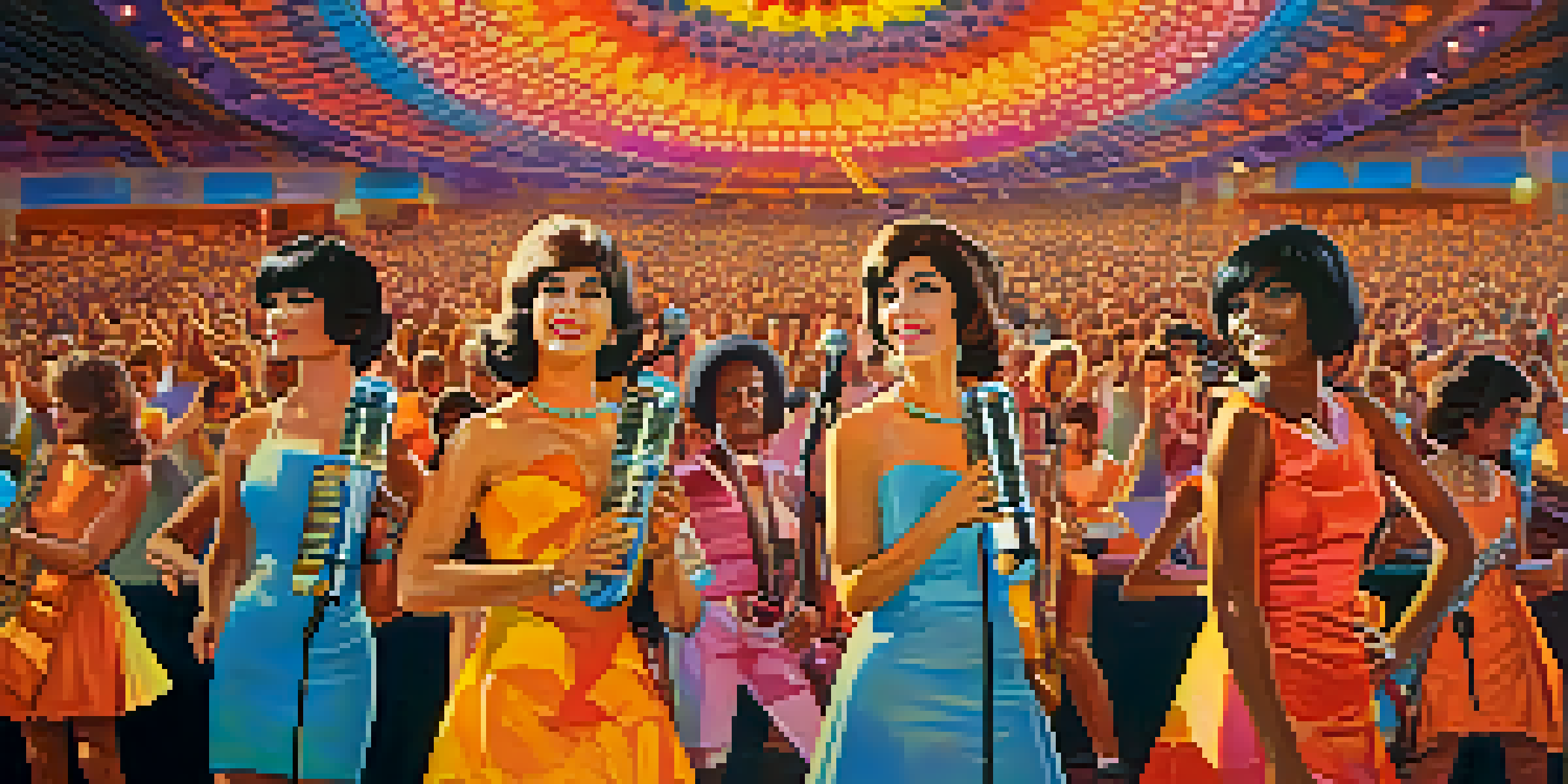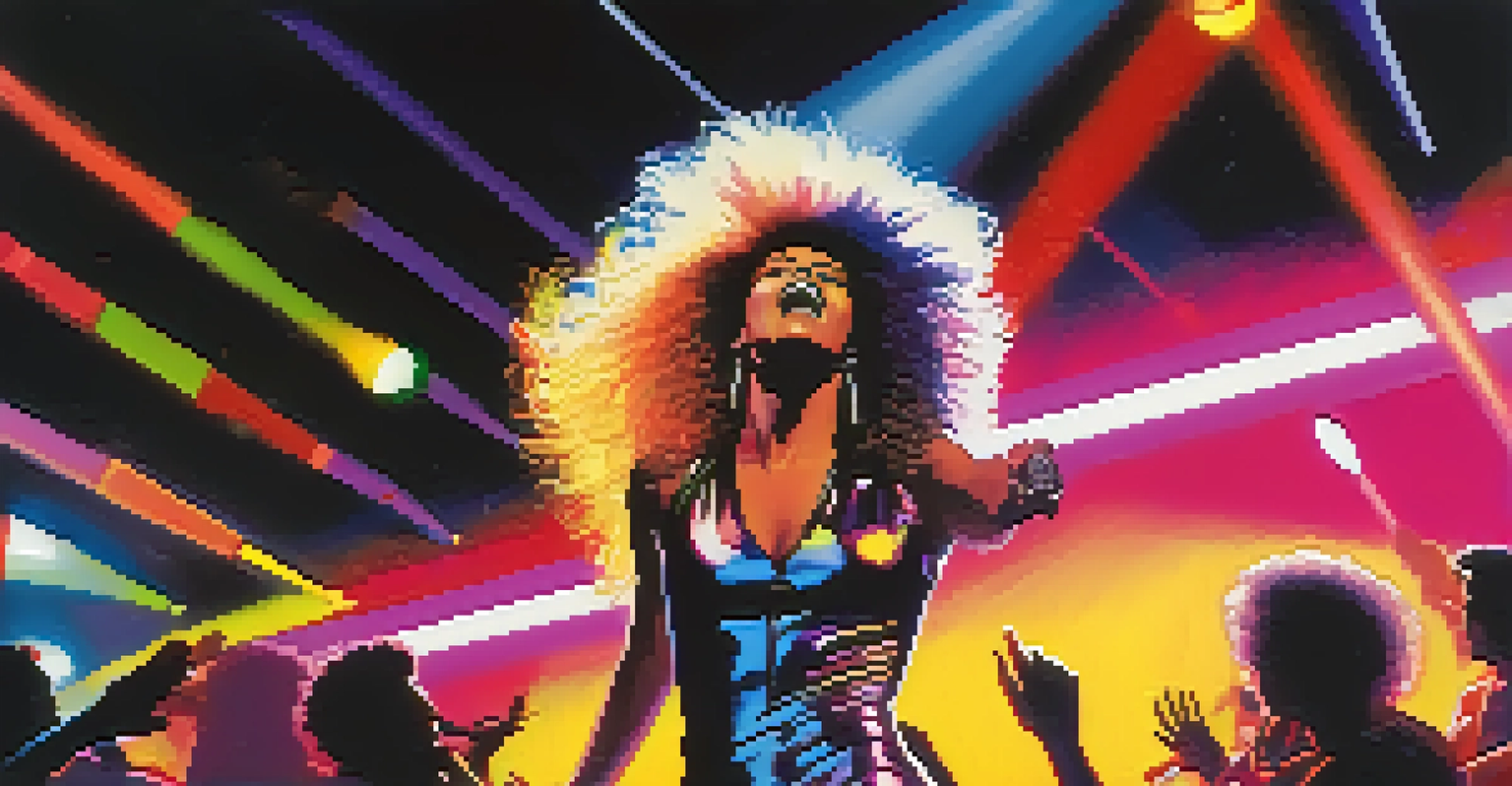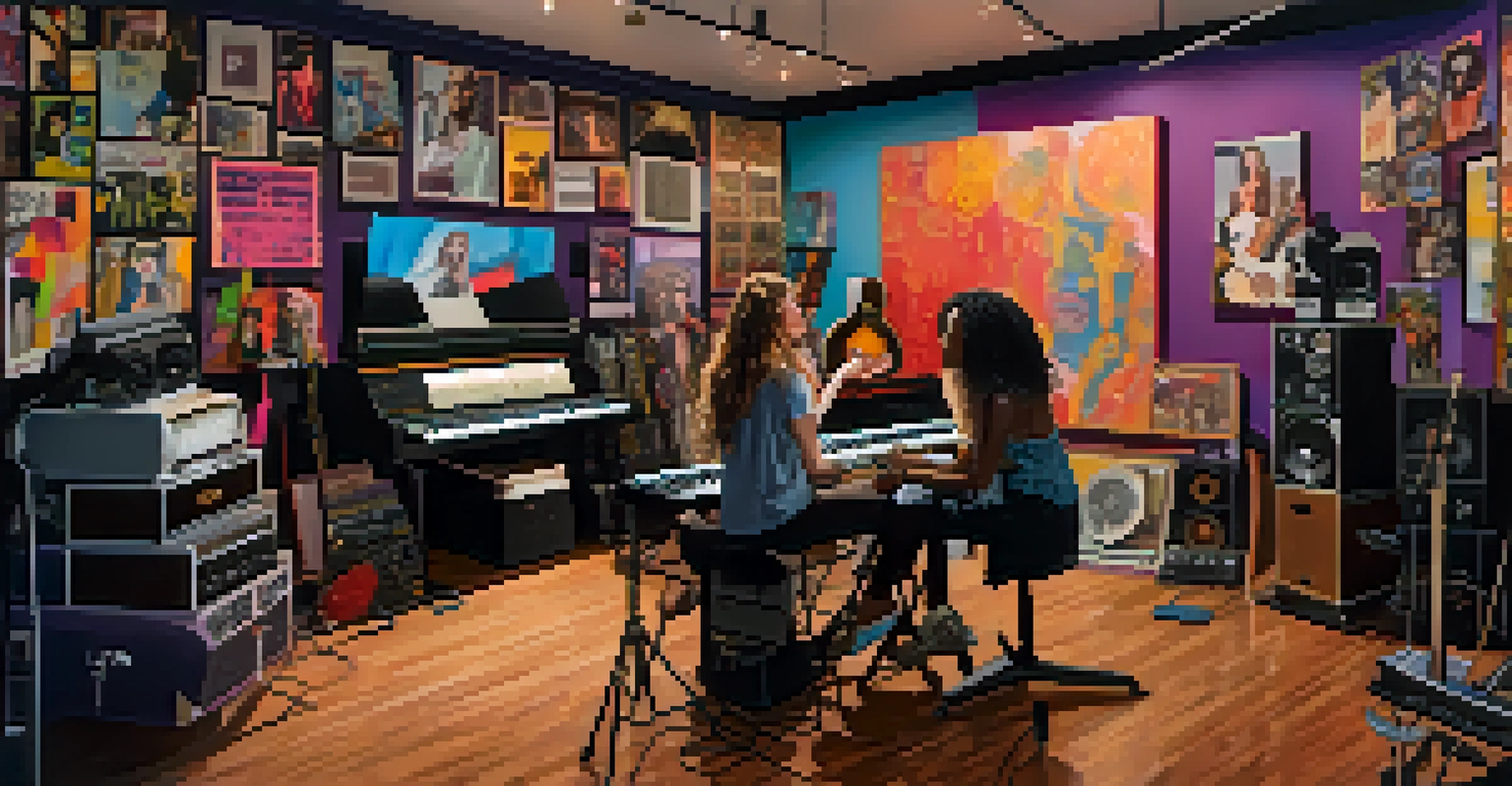The Evolution of Women in Pop Music: A Timeline

The 1950s: Pioneers of Pop and Rock 'n' Roll
The 1950s marked a significant turning point for women in music, with artists like Ella Fitzgerald and Billie Holiday paving the way. These pioneering women not only showcased their incredible vocal talents but also began to challenge societal norms. As rock 'n' roll emerged, figures like Brenda Lee and Connie Francis brought a fresh, youthful energy to the scene, proving that women could dominate a genre often seen as male-dominated.
The most beautiful thing you can wear is confidence.
This era also saw the rise of girl groups, such as The Shirelles and The Ronettes, who captured the hearts of many with their harmonies and style. Their success laid the groundwork for future female artists by demonstrating that women could successfully collaborate and create powerful music together. As these artists gained fame, they inspired many young women to pursue careers in music, setting a precedent for future generations.
However, despite their success, women still faced significant challenges in a male-dominated industry. The struggle for creative control and recognition was ongoing, but the groundwork laid in the 1950s would propel the next wave of female artists into the spotlight.
The 1960s: The Rise of Female Icons
The 1960s ushered in a new era of female empowerment in pop music, highlighted by icons like Aretha Franklin and Janis Joplin. Aretha's soulful voice and powerful lyrics resonated with many, making her an anthem for the civil rights movement. Meanwhile, Janis challenged traditional gender roles with her raw, emotional performances, proving that women could rock just as hard as men.

This decade also saw the emergence of folk music, with artists like Joan Baez and Joni Mitchell leading the charge. Their introspective songwriting and strong messages of social change opened doors for women in the singer-songwriter realm. They weren't just performers; they were voices for a generation, using their music to address important social issues.
Women Shaping Music Across Decades
From the 1950s to the 2020s, female artists have continually pushed boundaries and redefined the music industry.
As the decade progressed, the feminist movement gained momentum, influencing the music scene. Female artists began to write and produce their own music, gaining greater control over their careers and creative expression. This shift marked a significant step towards equality in the industry.
The 1970s: Diversification and Experimentation
The 1970s brought a wave of experimentation in pop music, with women like Stevie Nicks and Donna Summer pushing boundaries. Nicks, with her mystical persona and unique sound, became a symbol of rock's evolution, while Summer's disco hits made her a dance floor favorite. This blend of styles showcased the versatility of women in music, as they embraced genres from rock to disco.
Music can change the world because it can change people.
During this time, punk rock emerged, giving rise to fierce female artists like Debbie Harry of Blondie and Joan Jett. They not only contributed to the music but also challenged the status quo with their bold fashion choices and unapologetic attitudes. Their presence in the punk scene empowered many young women to express themselves freely.
Additionally, the decade saw the rise of the women's liberation movement, which influenced lyrical content and themes in music. Female artists began to explore topics of independence, love, and identity, providing a voice for women everywhere. The 1970s truly celebrated the diversity of women's experiences in the music industry.
The 1980s: Pop Queens and Market Domination
The 1980s were defined by the emergence of pop queens like Madonna and Whitney Houston, who dominated the charts and redefined the industry. Madonna's bold reinvention of her image and her exploration of sexuality made her a cultural icon. At the same time, Whitney's powerful voice and emotional ballads captured audiences worldwide, showcasing the diverse talents of women in pop.
This era also saw the rise of female empowerment anthems, with songs like 'I Will Survive' by Gloria Gaynor becoming rallying cries for women everywhere. These songs inspired a sense of independence and self-confidence, encouraging women to embrace their strength. The music videos of this time further emphasized female empowerment, often showcasing women in positions of power.
Empowerment Through Music Themes
Songs focusing on themes of empowerment, individuality, and social awareness have become anthems for women, inspiring change.
As MTV became the dominant platform for music, the visual representation of female artists became crucial. Women were now not only judged by their vocal abilities but also by their image and performance in music videos. This shift led to an era of glam and spectacle, as pop queens used visuals to enhance their music and message.
The 1990s: Genre Blending and New Voices
The 1990s witnessed an explosion of genre blending, with female artists like Alanis Morissette and TLC bringing fresh perspectives to pop music. Alanis's raw, emotional lyrics resonated with a generation, while TLC's mix of hip-hop and R&B broke barriers and addressed issues like self-respect and sexuality. Their success demonstrated that women could thrive in diverse musical landscapes.
This decade also saw the rise of the girl power movement, largely popularized by groups like the Spice Girls. Their catchy melodies and empowering messages resonated with young audiences worldwide, promoting friendship and self-expression. The Spice Girls became symbols of a new generation of women who embraced their individuality.
Furthermore, the 90s marked an important shift in the representation of women in music videos, as artists began to take control of their visual narratives. Female directors and choreographers played significant roles in shaping the aesthetics of the era, allowing women to showcase their artistry in innovative ways.
The 2000s: Empowerment Through Individuality
The 2000s introduced a new wave of individuality in pop music, with artists like Beyoncé and Lady Gaga leading the charge. Beyoncé's blend of R&B, pop, and hip-hop not only showcased her vocal prowess but also her ability to empower women through her music. Songs like 'Single Ladies' became anthems for independence and self-confidence.
Lady Gaga, with her avant-garde style and theatrical performances, pushed the boundaries of pop music and performance art. Her messages of acceptance and self-love resonated deeply, particularly within the LGBTQ+ community. The 2000s were a time of bold self-expression, encouraging women to embrace their true selves.
Diversity and Inclusion in Pop
The current music landscape showcases a rich diversity of female talent, emphasizing authenticity and representation.
This period also saw the rise of digital platforms, allowing female artists to reach broader audiences. Social media became a powerful tool for musicians to connect with fans and share their stories, leading to an unprecedented level of intimacy and engagement. The evolution of technology empowered women to carve out their own spaces in the industry.
The 2010s: Social Awareness and Authenticity
The 2010s marked a significant shift towards social awareness in pop music, with artists like Taylor Swift and Ariana Grande using their platforms for advocacy. Taylor's transition from country to pop included themes of personal growth and empowerment, while Ariana's music often addressed mental health and self-acceptance. These artists leveraged their influence to shed light on important issues, resonating with a socially conscious audience.
Additionally, the #MeToo movement brought attention to the struggles women faced in the industry, leading to a surge of female artists speaking out. This collective voice fostered a sense of solidarity among women in music, encouraging them to share their experiences and support one another. The music of the 2010s became a powerful tool for change and awareness.

Furthermore, the rise of independent artists challenged traditional music industry norms. Many women began to produce their own music, take control of their careers, and connect directly with fans. This newfound independence allowed for authentic storytelling that resonated with audiences on a deeper level.
The 2020s: A New Era of Diversity and Inclusion
As we enter the 2020s, the landscape of pop music continues to evolve, showcasing an incredible diversity of female talent. Artists like Billie Eilish and Lizzo are breaking barriers with their unique sounds and messages of body positivity and mental health awareness. This new wave of artists emphasizes the importance of authenticity and self-expression, appealing to a broader audience.
The industry is also becoming more inclusive, with a growing recognition of diverse voices and backgrounds. Women from various cultures and genres are gaining visibility, enriching the music scene with their unique perspectives. This shift is not only changing the sound of pop music but also expanding its reach and impact.
Moreover, the ongoing conversations surrounding mental health, equality, and representation are becoming integral to the narrative of women in music today. As artists continue to use their platforms for advocacy, the future of pop music looks promising, with women at the forefront of change and innovation.